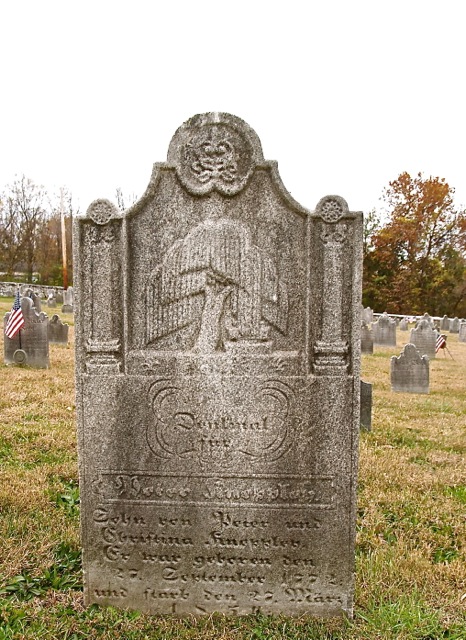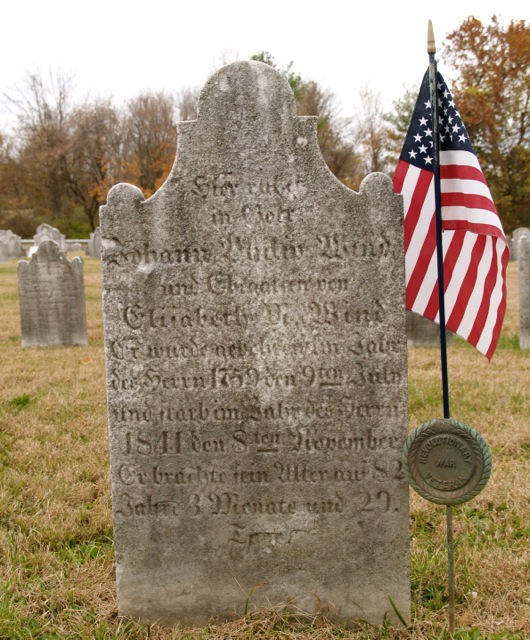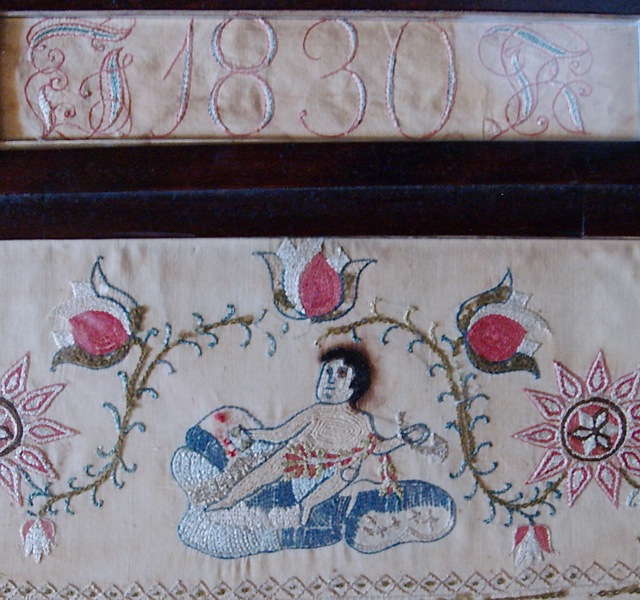The Elisabeth Köbler Embroidered Taufschein, part of the Goschenhoppen Historians Fraktur collection, is one-of-a-kind. Worked in 1830 by someone with the initials of J. K., it commemorates the birth and baptism of Elisabeth Köbler born fifty-four years earlier on October 9, 1776 at the “Blue Church” in Coopersburg, Pennsylvania. It’s hard to imagine what the occasion was that prompted the creation of the Taufschein. Whatever it may have been, this special gift definitely was intended to be a public remembrance for it is framed to be hung on a wall—of itself unusual—with the embroiderer’s initials and date of creation prominently visible.
- ILL. 1: Elisabeth Köbler Taufschein by J. K., 1830. Courtesy of Goschenhoppen Historians of Green Lane, Pa. 1971.01.55.
Original parish records for the “Blue Church” do exist, but are presently unavailable. Thus all following information is based on copies from several sources that were intended primarily as genealogical aids. It is hoped that some day soon the primary manuscripts will be available to confirm spellings, and to locate marginal notations that are so often not transcribed when extrapolating family history entries. Per these secondary sources of the birth and baptismal records of St. Paul’s Evangelical Lutheran Church in Coopersburg, Pennsylvania, often called the “Blue Church” because of the blue cast to its plastered stone exterior walls, Elisabeth Köbler, the baby featured in the embroidered Taufschein, was born October 9, 1776, the fifth child of Jacob Köbler and his wife Christina, née Kerschner, and baptized December 8, 1776. (Johann) Philip Wint/Wind, then aged seventeen, and Elisabeth Knöple were the godparents.
- ILL. 2: The “Blue Church” by Ron Pratt. Courtesy of St. Paul’s Evangelical Lutheran Church or the “Blue Church” of Coopersburg, Pa.
Jacob Kepler and Maria Christina, née Kirschener were married May 18, 1762 at the “Blue Church“ by Rev. Johann Andreas Friderich (Clarence E. Beckel, ed., Records of St. Paul’s Lutheran and Reformed Church (Blue Church) 1748-1892, Bethlehem, Pa: Bethlehem Public Library, 1937, p. 186). Georg and Margaretha Kerschner were Maria Christina’s parents. Jacob and Christina’s
- first child was Johan Georg born February 23, 1763.
- second Johann Jacob born April 4, 1765.
- third Johannes born June 5, 1771.
- fourth Maria C. born February 20, 1774.
- fifth Elisabeth born October 9, 1776.
- sixth Andreas born March 16, 1779.
- seventh Susanna born April 7, 1781.
The Köbler surname has a variety of spellings in the secondary sources such as Kepler, Keppel, Koepler, Käbler, Kebler, Kepple. It is not known if this is how they actually appear, or if the letters were incorrectly transcribed.
- ILL. 3: Peter Kneppley (1772-1854) grave marker at Friedens Church. Courtesy of Friedens Evangelical Lutheran Church of Friedensville, Pa.
Very little information has been found for Elisabeth Knöple (also Kneply, Kneeply, Kneple, Knepple, Kneppley), one of the sponsors. There is, however, an Elisabeth Kneply who took communion on October 31,1818 at St. Paul’s, and she may very well be the same person as Elisabeth’s sponsor. Records show that after Friedens Church was built at Friedensville, Pa in 1793, the Knepli family members began attending there. In fact, some of the Kneplis are buried in the old part of Friedens Church cemetery.
- ILL. 4: Johann Philip Wind (1759-1841) tombstone at Friedens Church. Courtesy of Friedens Evangelical Lutheran Church of Friedensville, Pa.
Johann Philip Wint/Wind (1759-1841), the other sponsor, was born to Andreas and Anna Elisabetha Catharina Wind on September 9, 1759. He was baptized at St. Paul’s Lutheran “Blue Church” on September 22, 1759, and per communion records maintained an active relationship with the church into the 1820s (C. Beckel, ed. Blue Church Records, p. 20). He also is known to have attended Friedens Lutheran Church on a regular basis after it was established in 1793. Per his last will and testament made July 19,1837 [Witnesses: Jacob Dillinger and Peter Newhard, and proved November 26, 1841], Wint/Wind was a very well-to-do tanner by trade, owning several tracts of land and tenements in both Upper Saucon, and Salisbury Townships, Lehigh County, Pennsylvania. It has been suggested that he may have been an organ builder or musician. This does not seem to be the case for he mentions nothing about being a keyboard or organ builder in his last testament whereas he does mention that he has a tannery that he is bequeathing to his son Andrew, and makes other references to the tanning trade, which obviously was his principal occupation. According to a credit entry for Philip Wint, Sr in the original Friedens Church account records, he actively supported building and maintenance projects up to May 1841. He died November 8, 1841 and is buried in row five of the old part of Friedens Church cemetery next to his wife Elisabeth Mohry Wind/Wint.
- ILL. 5: Elisabeth Köbler Taufschein, Enlargement of J 1830 K. Courtesy of Goschenhoppen Historians of Green Lane, Pa. 1971.01.55.
The Goschenhoppen Historians bought the Elisabeth Köbler Taufschein from Elwood Hoot, an auctioneer at West Point near Lansdale, PA for $125 ca. 1964-1970 according to an accession note, and entered it officially into the collection in 1972. Both the separately embroidered initials and year J 1830 K, and the Elisabeth Köbler Taufschein are worked in cotton thread, two ply polychrome silk thread and wool yarn on a bleached cotton ground. Kinds of stitches include: cross, chain, and French knot.
- ILL. 6: Maria Schmid Taufschein by Michael Frölich. Heinrich Ebner & Co., 1822. Courtesy of Allentown Art Museum. 2009.006.031.
The embroiderer replicated in her embroidery the main decorative elements Heinrich Ebner (1783-1850), printer in Allentown, Pennsylvania used in his printed Taufscheins of the early 1820s. These include the reclining putto atop a billowing cloud in the center at the top of the piece. He is facing to the left, and holding a hunting horn in his left hand, a sealed envelope in his right. Facing inwards and standing on clouds are two angels, who flank the central birth/baptismal text. Both are equipped with lyres: The one on the right is holding a wreath with her raised right arm, and the other on the left is looking at a bird perched on her elevated left hand. Below each angel is a bird sitting on upward-stretching boughs, grasping at berries above him. Branch and bird form a symmetrical unit and face inwards. The embroiderer added additional elements not present on the Ebner Taufschein such as floral vines of tulips and flowers reminiscent of the sun; a cherry tree in front of each angel, and a sleek bird at her feet. The ever present baptismal verses announcing the brevity of life and importance of baptism usually found on printed Taufscheins of the period are noticeably absent from this piece.
The birth and baptismal certificate is not only embroidered, but also originally watercolor or tempera was used to paint the putto’s hair and body, as well as the angels’ faces and arms. Its mahogany veneer-on-pine frame is original to the Taufschein, which was intended to be a display piece. Dorothy McCoach, a leading textile conservator, conserved the piece in 1996, at which time the embroidered Taufschein was removed from the frame and its tacked mounting. Upon completion of conservation procedures, the two embroidered pieces were hand-stitched to cotton polyester slipjacketed 4 ply museum board and reframed in the original frame. The two original wood backings were returned to the Goschenhoppen Historians. It was hoped that perhaps additional information about Elisabeth Köbler had been appended to the backings, but, per Mrs. McCoach in an email response of October 26, 2015, nothing was written on either one.
Fortunately, with digital magnification, it is possible to read the much faded embroidered Fraktur script:
Transcription
Geburt und Taufschein
Diese beyde Ehegatten als Jacob Köbler | und seiner ehelichen Hausfrau Christina | eine gebohrne Kerschnern ist ein Dochter zur | Welt gebohren den 9ten Tag October | im Jahr unsers Herrn 1776 Diese | Dochter ist getauft worden und ehielt | den Namen Elisabeth die Taufzeugen | waren Philip Wint und Elisabeth Knöple.
Translation
Birth and Baptismal Certificate
A daughter was born to these two married people Jacob Köbler and his legal wife Christina, maiden name Kerschner, on the 9th of October in the Year of Our Lord 1776. This daughter was baptized and received the name Elisabeth. The sponsors were Philip Wint and Elisabeth Knöple.
The embroiderer of Elisabeth Köbler’s Taufschein had to be someone, either a family member or a friend, who had access to Elisabeth’s birth and baptismal information possibly from St. Paul’s Lutheran “Blue Church” records or from a family member. Had there been an original birth and baptismal certificate from which to work, one suspects the motifs from Ebner’s printed Taufschein, contemporary to the time in which the needleworker was actually making the piece, would not have been substituted for original decorative elements. We don’t know if Elisabeth was still alive in 1830, but if so, as already mentioned, she would have been fifty-four years old. Johann Philip Wind is the only one for whom we have additional records attesting to some of his life activities. The needleworker who worked this embroidery could never have guessed that this token of her hands and heart would one day be one of the very few footprints left to show that Elisabeth Köbler, her family, and her baptismal sponsors ever walked this earth.
Sources
Brunner, Raymond J. That Ingenious Business: Pennsylvania German Organ Builders. Publications of the Pennsylvania German Society, vol. 24, Birdsboro, Pa.: Pennsylvania German Society, 1990, 177. [Re. Wint]
Church Records at St. Paul’s “Blue” Churc,h Upper Saucon Township, Lehigh County, PA., transcribed from a copy in Easton Public Library 1948. T.S. Housed at St. Paul’s Blue Church, 5900 Applebutter Hill Road, Coopersburg, PA 18036-9500.
Das ist Daß Trosties und Kirchen Buch Vor Die gemeine friedens kirch in ober Sackunna Taunschip Northampton Caunty Den 25ten februarius 1797 [Friedensville, Pa., 1797].
Gehret, Ellen. This is the Way I Pass My Time: A Book About Pennsylvania German Decorated Hand Towels (Birdsboro, PA: Pennsylvania German Society, 1985).
Glattfelter, Charles H. Pastors and People: German Lutheran and Reformed Churches in the Pennsylvania Field, 1717-1793, vol. 1 of 2. Publications of the Pennsylvania German Society, vols. 13, 15, Breinigsville, Pa.: Pennsylvania German Society, 1980-81, 346-347 (Friedens Church), 357-358 (St. Paul’s Blue Church).
Kirchen Buch| für die Gemeine in Sauccunen in sich haltend | Getaufte, Copulirte und Verstorbene Leute angefangen im Jahr Christ 1748, St. Paul’s Blue Church, 5900 Applebutter Hill Road, Coopersburg, PA 18036-9500 [Presently unavailable].
Stopp, Klaus. The Printed Birth and Baptismal Certificates of the German Americans, vol.1 of 6. Mainz, Germany and East Berlin, Pa: privately published, 1997-1999, 157-63.
[Re. Heinrich Ebner]
Wind, John Philip Find a Grave. http://www.findagrave.com/cgi-bin/fg.cgi?page=gr&GRid=80213507&ref=acom Accessed 28 October 2015.
_______________. Last Will and Testament: Probate Records, 1812-1920 ; Index 1812-1965;
Author: Lehigh County (Pennsylvania). Register of Wills; Probate Place: Lehigh, Pennsylvania.
My thanks to Bob Wood, Nancy Roan, and Linda Szapacs of the Goschenhoppen Historians; Dorothy McCoach, Textile Conservator Consultant; the Rev. James Hammond, and Kathy Exner of St. Paul’s Evangelical Lutheran “Blue Church” of Coopersburg, Pa.; the Rev. Lisa Borrell, Don Trump, Harvey Kichline, and Jeanette Petersen of Friedens Evangelical Lutheran Church, Center Valley, Pa.
Blog Post including transcriptions; translations; and photo images
© 2015 Del-Louise Moyer







Del—
Your quality photographs and their placement within the article added to my enjoyment of your latest post. Thank you for your work and your sharing.
Marsha Campbell
LikeLike
Many thanks Marcia for always inspiring me with your kind words!
LikeLike
Del,
Well, you’ve done it again! i wish I had your energy! Another excellent article with supporting photos. . I like the way you integrate the photos, genealogy,and all the details of the story. Could you publish your blogs on paper sometime?
LikeLike
That all means much coming from such a fine writer as you! Thank you! Could I publish my blogs? Probably…
LikeLike
Del,
Even though I know nothing of Elizabeth or the others named, I feel as if I do after reading your blog. This is only the second blog I’ve read, be sure I will read more. Thank you for sharing your myriad talents and bringing history alive for all of us.
LikeLike
I love to “light up the past” for a brief second Mary Ann…to grab hold of the ephemeral and let it live for a moment or two in that time sphere we call the present. I’m looking forward to finding more records about Elisabeth Köbler and discovering why someone embroidered the record of her birth fifty-four years after she was born!
LikeLike
This is a fascinating read as I prepare to docent in the Goschenhoppen Museum this weekend. This piece has always been one of my favorites in the collection. Also I live on Blue Church Rd., right up from the church. I have wondered about the origin of its name as only the doors are truly blue. My husband, who was born and raised here, often refers to the blue granite so prevalent in old local buildings. You just confirmed his theory. Many thanks! Ronnie Arena
LikeLike
The plaster that was put on top of the stone as insulation had a bluish cast to it. It was because of this bluish tint that St. Paul’s Evangelical Church was and is nicknamed the “Blue Church.” Today’s church is not plastered, so I very much like your husband’s observation of the blue in the granite, and yours about the blue church doors as reasons why we can still call it the “Blue Church.” It has the most beautiful setting, and is well worth taking the time to visit it, and its historic graveyard.
LikeLike
So interesting; is this the only known embroiderd taufschein? Joan
LikeLike
The Köbler Taufschein is one-of-a-kind. However there are birth records in varying degrees of detail embroidered on
• TABLECLOTHS (See: Winterthur collection).
http://museumcollection.winterthur.org/single-record.php?resultsperpage=20&view=catalog&srchtype=advanced&hasImage=&ObjObjectName=&CreOrigin=&Earliest=&Latest=&CreCreatorLocal_tab=&materialsearch=&ObjObjectID=&ObjCategory=&DesMaterial_tab=&DesTechnique_tab=&AccCreditLineLocal=&CreMarkSignature=&recid=1966.1127&srchfld=&srchtxt=Taufschein&id=74c3&rownum=61&version=100&src=results-imagelink-only#.VmIRB0tC8pF
• SAMPLERS (See: Tandy and Charles Hersh. Samplers of the Pennsylvania Germans (Birdsboro, PA: Pennsylvania German Society, 1991), p. 184.
• SHOW TOWELS (See: Ellen J. Gehret. This is the Way I Pass My Time: A Book About Pennsylvania German Decorated Hand Towels (Birdsboro, PA: Pennsylvania German Society, 1985), p. 169.
For a good read on TEXTS embroidered on towels see: Gehret, pp. 216-227.
LikeLike
Thanks
LikeLike
Masterfully documented and composed, once again! The 54 year gap is certainly intriguing. Thanks, Del-Louise.
LikeLike
Wonderful as always! I agree with Robert Wood. Can you publish your blogs on paper some day?
Corinne
LikeLike
Del,
Thanks so much for all the wonderful information about the taufschein. It is a beautiful, intriguing treasure that has fascinated me for years. Like my friend Ronnie, I too live close to Blue Church and was delighted to see this very local connection. I’m wondering if there is a way to connect your blog post to the PastPerfect online catalog record on this piece.
LikeLike